Why You Should Focus On Enhancing Self Propelled Wheelchair
нҺҳмқҙм§Җ м •ліҙ
мһ‘м„ұмһҗ Teri лҢ“кёҖ 0кұҙ мЎ°нҡҢ 3нҡҢ мһ‘м„ұмқј 24-11-25 01:44ліёл¬ё
 self propelled wheelchair with attendant brakes (please click the up coming document)
self propelled wheelchair with attendant brakes (please click the up coming document) self propelled wheelchairs lightweight-propelled wheelchairs equipped with attendant brakes are a great option for those who need extra stability and support when traveling. They come with rear-drive wheels and a range of accessories that can be added, such as flip-up leg rests that swing away or flip-down armrests.
self propelled wheelchairs lightweight-propelled wheelchairs equipped with attendant brakes are a great option for those who need extra stability and support when traveling. They come with rear-drive wheels and a range of accessories that can be added, such as flip-up leg rests that swing away or flip-down armrests.Unfortunately, there have been very few biomechanical studies of the manoeuvring and turning of propelled wheelchairs with attendants. This area requires more research.
Seat length
The width of a wheelchair seat is the distance between the frame's edges. It is important to think about this when selecting the right chair, since various users will require different dimensions. For instance, those who have larger thighs might require an extra wide seat. To determine a suitable size, sit in the chair and take a measurement of the width of your thigh. The best way to measure is using a yardstick. It will give you a precise measurement.
It is essential to take into consideration the seat width of an automatic wheelchair equipped with attendant brakes, specifically for caregivers. A seat that is larger will let the user move more comfortably and freely. This makes it easier for caregivers to maneuver the chair around tiny spaces. A lot of attendant controlled wheelchairs are lightweight and have smaller wheels that allow for easy moving and pushing. They are perfect for those who have limited upper body strength and coordination.
A wheelchair must also have brakes that are easy to use. They are essential for ensuring safety while driving and when transferring. They also improve the occupants' independence and reduce stress. Research conducted at Dundee University has shown that the most effective braking system for wheelchairs is one with a foot lever that is easily operated and operated with one hand.
Attendant controlled wheelchairs are smaller than self-propelled wheelchairs, which have large rear wheels and hand rims. They are designed to be pushed manually by caregivers. These wheelchairs are perfect for people with weak upper body strength. They are also able to be easily moved and used in a variety of environments. Most models also feature cable brakes for increased safety and convenience. Some even fold flat, making them perfect for storage and transport in a car. In addition, most models prioritize the user's comfort by offering features such as armrests and seats that are cushioned.
Seat height
The seat height of a self-propelled wheelchair with attendant brakes may vary significantly and must be carefully considered. The most comfortable position is sufficient height that allows the person to sit straight and unaffected by strain. However, the height of the seat can affect the amount of force required to push the wheelchair forward. This can have a major impact on the performance of a wheelchair, and is especially important when a wheel chair has front-wheel drives.
The positioning of the pushing handles can make a huge difference to the ease with the wheelchair can be moved. Most current wheelchairs feature handles that are placed horizontally across the rear of the frame or as backward-pointing levers extending from the back of the chair. Recent pushing studies have shown that these handles do not work well for wheelchairs.
Wheelchairs are utilized by a wide variety of people in homes and hospital settings as well as in other places. Many of these people are disabled and require assistance in order to move around. Attendants, which are usually relatives or friends of the occupant might not be able to walk and may find it difficult to manoeuvre wheelchairs outdoors and indoors. They may also face difficulties getting the person out of the wheelchair.
The ability of the attendant to control the wheelchair in a chaotic environment is a major issue. A wheelchair that can maneuver well is crucial, as is a wide set of wheels and puncture-proof tyres. A well-constructed castor trail (the distance between the wheel axis and the axes of the handle holder) is also necessary to ensure an enjoyable ride.
The Ugo Esteem lightweight folding self propelled wheelchair self propelled wheelchairs for sale near me Propelled Wheelchair with Attendant Brakes is a great example of a well-designed wheelchair that is easy to push. This model features a lightweight aluminum frame, with a two-year frame warranty and puncture-proof tyres. It has adjustable footplates as well as armrests, an elevated leg rest option (please choose from the drop-down menu) and a compact folding frame making it easy to transport and store.
Seat depth
The seat's depth what is the lightest self propelled wheelchair an important element in determining how easy it is to move the wheelchair. A seat with a deeper depth can prevent the user from falling off of the chair. A seat that is not deep can cause discomfort and injury. Ideally, a wheelchair should have a depth of at least 2 inches. This will enable you to get around small obstacles and climb over kerbs.
The height of the armrests and seat are also crucial in determining the correct size of wheelchair for a particular. A taller individual will need an upper seat, while a shorter one will require one that is lower. If the wheelchair is to be used to support postural needs, the backrest should be higher than the normal. This will ensure that the wheelchair is comfortable for the user and will allow them to sit upright.
The force applied to the wheels determines the rolling resistance of a wheelchair. The force is based on the wheel's radius of curvature and the condition of the surface. The wheels can be made to reduce their resistance to rolling by making use of soft rubber, thereby reducing the friction between the road and the tire or by increasing the rim width. Furthermore, the wheel's force of inertia is an important element, and can be reduced by altering the design of the castor.
The ugo Esteem Self-Powered Wheelchair is an example. It has a castor path that is adjusted according to the individual. This makes it easier to turn and less likely to slide when starting from a rest position. The adjustable footrest height and angle, the seat cushion and backrest make it more suited for each user.
You can determine the height of a chair by measuring the distance between the base of your spine and the back of your knee. This measurement is typically made by a caregiver in order to prevent injury to the wheelchair user. It is important to consider whether the user requires a footrest, and if so the height.
Armrests
Wheelchairs are used frequently by nurses on hospital wards for moving patients between departments and also as the main mode of transportation for patients who are not able to walk. Transferring patients in and out of wheelchairs is a challenging task for attendants, who need to lift them repeatedly and push and maneuver the chair on different terrains. The ergonomic design of these chairs must strive to make propulsion as well as general operation as simple for the attendants by minimising the physical demands they place on them. This means that the handling characteristics of the chairs, like their resistance to rolling, the resistance to turning, the height of the handle, and the position of the brakes need to be designed biomechanically in order to maximize the comfort of the attendants.
The armrests of a self-propelled wheelchair equipped with brakes should be placed properly to allow people who have strong arms to assist themselves in getting out of the chair. They must also be able to be removed in order that they do not block the access for those who have more disabilities when they are lifted into the seat. The prototype chair made in Dundee had armrests that extended outward to give support to users' hands and could be folded when not needed.
It is crucial that the chair is comfortable and safe regardless of whether the person sits in it for a long period of time or just for a few minutes. The padded backrest and seat of this model are upholstered with wipe clean nylon, which is tough and durable. The foot rests of this model can be moved and swung away to make transfers easier.
The lightweight attendant controlled chair has a number of features that are helpful for the caregiver or the attendant. They include adjustable footplates, flip-up, armrests that can be removed to aid with side transfers and aid them get closer to their desks and cable brakes to reduce speed and a stepping tube for climbing curbs. It also comes with an adjustable backrest that folds down for easy storage and transportation. The lightweight wheelchair comes in two sizes and comes with a 12 month warranty as standard.
- мқҙм „кёҖThe Hidden Secrets Of Men Masturbation Toys 24.11.25
- лӢӨмқҢкёҖBanners And Signs - A Great Marketing Investment 24.11.25
лҢ“кёҖлӘ©лЎқ
л“ұлЎқлҗң лҢ“кёҖмқҙ м—ҶмҠөлӢҲлӢӨ.